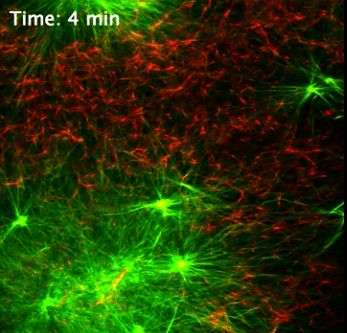Seeing 'living' nanofibers in real time

The Greek goddess Psyche borrowed help from ants to sort a room full of different grains. Cells, on the other hand, do something similar without Olympian assistance, as they organize molecules into robust, functional fibers. Now scientists are able to see self-sorting phenomena happen in real time with artificial molecules.
The achievement, reported in Nature Chemistry, elucidates how two different types of nanofibers sort themselves into organized structures under artificial conditions.
"Basic cellular structures, such as actin filaments, come into being through the autonomous self-sorting of individual molecules, even though a tremendous variety of proteins and small molecules are present inside the cell," says lead author Hajime Shigemitsu, a researcher in Itaru Hamachi's lab at Kyoto University.
"Imagine a box filled with an assortment of building blocks—it's as if the same type of blocks started sorting themselves into neat bundles all on their own. In living cells, such phenomena always happen, enabling accurate self-assembling of proteins, which is essential for cell functions."
"If we are able to control self-sorting with artificial molecules, we can work toward developing intelligent, next-generation biomimics that possess the flexibility and diversity of functions that exist in a living cell."
Study co-author Ryou Kubota explains that previous studies have already made artificial molecules build themselves into fibers—but only when there was one type of molecule around. Having a jumble of types, on the other hand, made the molecules confused.
"The difficulty in inducing self-assembly with artificial molecules is that they don't recognize the same type of molecule, unlike molecules in the natural world. Different types of artificial molecules interact with each other and make an unsorted cluster."
From a database of structural analyses, Hamachi and colleagues discovered a combination of nanofibers—namely a peptide-based and lipid-based hydrogelator—that would make sorted fibers without mixing with the other. They then tethered the fibers with fluorescent probes; with a type of microscope typically used in cell imaging, the team was able to observe directly and in real-time how the artificial molecules sorted themselves.
"Ultimately, this finding could help develop new materials that respond dynamically to different environments and stimuli," elaborates Hamachi. "This insight is not only useful for materials science, but may also provide useful clues for understanding self-organization in cells."
More information: Enda Bergin, Organic synthesis: Made by machine, Nature Chemistry (2015). DOI: 10.1038/NCHEM.2256
Journal information: Nature Chemistry
Provided by Kyoto University



















